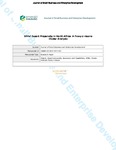SMEs’ Export Propensity in North-Africa: A Fuzzy c-means Cluster Analysis
| dc.contributor.author | Haddoud, Mohamed Yacine | |
| dc.contributor.author | Malcolm Beynon, | |
| dc.contributor.author | Paul Jones, | |
| dc.contributor.author | Robert Newbery, | |
| dc.date.accessioned | 2017-06-17T18:29:16Z | |
| dc.date.issued | 2017-08 | |
| dc.identifier.issn | 1462-6004 | |
| dc.identifier.uri | http://hdl.handle.net/10026.1/9489 | |
| dc.description.abstract |
<jats:sec> <jats:title content-type="abstract-subheading">Purpose</jats:title> <jats:p>The purpose of this paper is to analyse the determinants of small and medium-sized enterprises’ (SMEs) propensity to export using data from a North African country, namely Algeria. Drawing on the extended resource-based view, the study examines the role of firms’ resources and capabilities in explaining the probability to export.</jats:p> </jats:sec> <jats:sec> <jats:title content-type="abstract-subheading">Design/methodology/approach</jats:title> <jats:p>The study employs the nascent fuzzy <jats:italic>c</jats:italic>-means clustering technique to analyse a sample of 208 Algerian SMEs. The sample included both established and potential exporters operating across various sectors. A combination of online and face-to-face methods was used to collect the data.</jats:p> </jats:sec> <jats:sec> <jats:title content-type="abstract-subheading">Findings</jats:title> <jats:p>While a preliminary analysis established the existence of five clusters exhibiting different levels of resources and capabilities, further discernment of these clusters has shown significant variances in relation to export propensity. In short, clusters exhibiting combinations that include higher levels of export-oriented managerial resources showed greater export propensity, whereas clusters lacking such assets were less likely to display high export propensity, despite superior capabilities in marketing and innovation.</jats:p> </jats:sec> <jats:sec> <jats:title content-type="abstract-subheading">Practical implications</jats:title> <jats:p>The findings provide a more comprehensive insight on the critical resources shaping SMEs’ internationalisation in the North African context. The paper holds important implications for export promotion policy in this area.</jats:p> </jats:sec> <jats:sec> <jats:title content-type="abstract-subheading">Originality/value</jats:title> <jats:p>The study makes a twofold contribution. First, the use of the fuzzy <jats:italic>c</jats:italic>-means clustering technique to capture the joint influence of discrete resources and capabilities on SMEs’ export propensity constitutes a methodological contribution. Second, being the first study bringing evidence on SMEs’ internationalisation from the largest country in the African continent, in terms of landmass, constitutes an important contextual contribution.</jats:p> </jats:sec> | |
| dc.format.extent | 769-790 | |
| dc.language | en | |
| dc.language.iso | en | |
| dc.publisher | Emerald | |
| dc.title | SMEs’ Export Propensity in North-Africa: A Fuzzy c-means Cluster Analysis | |
| dc.type | journal-article | |
| dc.type | Journal Article | |
| plymouth.issue | 5 | |
| plymouth.volume | 25 | |
| plymouth.publication-status | Published | |
| plymouth.journal | Journal of Small Business and Enterprise Development | |
| dc.identifier.doi | 10.1108/JSBED-02-2017-0077 | |
| plymouth.organisational-group | /Plymouth | |
| plymouth.organisational-group | /Plymouth/Faculty of Arts, Humanities and Business | |
| plymouth.organisational-group | /Plymouth/REF 2021 Researchers by UoA | |
| plymouth.organisational-group | /Plymouth/REF 2021 Researchers by UoA/UoA17 Business and Management Studies | |
| dcterms.dateAccepted | 2017-06-16 | |
| dc.rights.embargodate | 2018-7-20 | |
| dc.rights.embargoperiod | 24 months | |
| rioxxterms.versionofrecord | 10.1108/JSBED-02-2017-0077 | |
| rioxxterms.licenseref.uri | http://www.rioxx.net/licenses/under-embargo-all-rights-reserved | |
| rioxxterms.licenseref.startdate | 2017-08 | |
| rioxxterms.type | Journal Article/Review |


